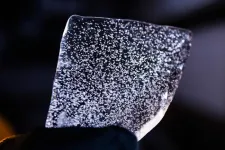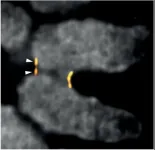(Press-News.org) CORVALLIS, Ore. – Today’s rate of atmospheric carbon dioxide increase is 10 times faster than at any other point in the past 50,000 years, researchers have found through a detailed chemical analysis of ancient Antarctic ice.
The findings, just published in the Proceedings of the National Academy of Sciences, provide important new understanding of abrupt climate change periods in Earth’s past and offer new insight into the potential impacts of climate change today.
“Studying the past teaches us how today is different. The rate of CO2 change today really is unprecedented,” said Kathleen Wendt, an assistant professor in Oregon State University’s College of Earth, Ocean, and Atmospheric Sciences and the study’s lead author.
“Our research identified the fastest rates of past natural CO2 rise ever observed, and the rate occurring today, largely driven by human emissions, is 10 times higher.”
Carbon dioxide, or CO2, is a greenhouse gas that occurs naturally in the atmosphere. When carbon dioxide enters the atmosphere, it contributes to warming of the climate due to the greenhouse effect. In the past, the levels have fluctuated due to ice age cycles and other natural causes, but today they are rising because of human emissions.
Ice that built up in Antarctic over hundreds of thousands of years includes ancient atmospheric gasses trapped in air bubbles. Scientists use samples of that ice, collected by drilling cores up to 2 miles (3.2 kilometers) deep, to analyze the trace chemicals and build records of past climate. The U.S. National Science Foundation supported the ice core drilling and the chemical analysis used in the study.
Previous research showed that during the last ice age, which ended about 10,000 years ago, there were several periods where carbon dioxide levels appeared to jump much higher than the average. But those measurements were not detailed enough to reveal the full nature of the rapid changes, limiting scientists’ ability to understand what was occurring, Wendt said.
“You probably wouldn’t expect to see that in the dead of the last ice age,” she said. “But our interest was piqued, and we wanted to go back to those periods and conduct measurements at greater detail to find out what was happening.”
Using samples from the West Antarctic Ice Sheet Divide ice core, Wendt and colleagues investigated what was occurring during those periods. They identified a pattern that showed that these jumps in carbon dioxide occurred alongside North Atlantic cold intervals known as Heinrich Events that are associated with abrupt climate shifts around the world.
“These Heinrich Events are truly remarkable,” said Christo Buizert, an associate professor in the College of Earth, Ocean, and Atmospheric Sciences and co-author of the study. “We think they are caused by a dramatic collapse of the North American ice sheet. This sets into motion a chain reaction that involves changes to the tropical monsoons, the Southern hemisphere westerly winds and these large burps of CO2 coming out of the oceans.”
During the largest of the natural rises, carbon dioxide increased by about 14 parts per million in 55 years. And the jumps occurred about once every 7,000 years or so. At today’s rates, that magnitude of increase takes only 5 to 6 years.
Evidence suggests that during past periods of natural carbon dioxide rise, the westerly winds that play an important role in the circulation of the deep ocean were also strengthening, leading to a rapid release of CO2 from the Southern Ocean.
Other research has suggested that these westerlies will strengthen over the next century due to climate change. The new findings suggest that if that occurs, it will reduce the Southern Ocean’s capacity to absorb human-generated carbon dioxide, the researchers noted.
“We rely on the Southern Ocean to take up part of the carbon dioxide we emit, but rapidly increasing southerly winds weaken its ability to do so,” Wendt said.
Additional coauthors include Ed Brook, Kyle Niezgoda and Michael Kalk of Oregon State; Christoph Nehrbass-Ahles of the University of Bern in Switzerland and the National Physical Laboratory in the United Kingdom; Thomas Stocker, Jochen Schmitt and Hubertus Fischer of the University of Bern; Laurie Menviel of the University of New South Wales in Australia; James Rae of the University of St. Andrews in the United Kingdom; Juan Muglia of Argentina; David Ferreira of the University of Reading in the United Kingdom and Shaun Marcott of University of Wisconsin-Madison.
END
Researchers identify fastest rate of natural carbon dioxide rise over the last 50,000 years
2024-05-13
ELSE PRESS RELEASES FROM THIS DATE:
Research on centromere structure yields new insights into the mechanisms of chromosome segregation errors
2024-05-13
Researchers from the Kops group in collaboration with researchers from the University of Edinburgh, made a surprising new discovery in the structure of the centromere, a structure that is involved in ensuring that chromosomes are segregated properly when a cell divides. Mistakes in chromosome segregation can lead to cell death and cancer development. The researchers discovered that the centromere consists of two subdomains. This fundamental finding has important implications for the process of chromosome segregation and provides new mechanisms underlying erroneous divisions in cancer cells. The research was published in Cell on May 13th 2024.
Our bodies consist of trillions of ...
Ochsner Medical Center-Baton Rouge earns Acute Stroke Ready Certification from Joint Commission
2024-05-13
BATON ROUGE, La. – Ochsner Medical Center - Baton Rouge has earned The Joint Commission’s Gold Seal of Approval® and the American Stroke Association’s Heart-Check mark for Acute Stroke Ready Certification.
The designation means OMC-Baton Rouge meets The Joint Commission's designation for readiness to treat patients who experience severe stroke.
To achieve certification, OMC-Baton Rouge underwent a rigorous, unannounced onsite. During the visit, a team of Joint Commission reviewers evaluated compliance with numerous certification standards, including ...
CEHD researchers studying family-led early childhood systems change for educational equity
2024-05-13
CEHD Researchers Studying Family-Led Early Childhood Systems Change For Educational Equity
Colleen Vesely, Associate Professor, College of Education and Human Development (CEHD); Bethany Letiecq, Associate Professor, Research Methods, CEHD; Rochelle Davidson Mhonde, Assistant Professor, Global and Community Health; and Jung Yeon Park, Assistant Professor of Quantitative Research Methods, School of Education, received funding for the project: “Family-Led Early Childhood Systems Change ...
Raz receives funding for Intent-Based Orchestration In Distributed Command & Control (IBODC2) software
2024-05-13
Raz Receives Funding For Intent-Based Orchestration In Distributed Command & Control (IBODC2) Software
Ali ...
Kelly receives funding for civil war graffiti preservation
2024-05-13
Kelly Receives Funding For Civil War Graffiti Preservation
Mills Kelly, Senior Scholar and Former Director, Roy Rosenzweig Center for History and New Media (RRCHNM); Professor, History, has received funding from the National Endowment for the Humanities for: “Off the Wall: Digital Preservation of Civil War Graffiti Houses.”
Kelly will use the funding to support the building and publishing of a digital archive focused on soldiers’ graffiti found in Civil War-era structures located in the ...
New viruses on the horizon
2024-05-13
Suddenly they appear and - like the SARS-CoV-2 coronavirus - can trigger major epidemics: Viruses that nobody had on their radar. They are not really new, but they have changed genetically. In particular, the exchange of genetic material between different virus species can lead to the sudden emergence of threatening pathogens with significantly altered characteristics. This is suggested by current genetic analyses carried out by an international team of researchers. Virologists from the German Cancer Research Center (DKFZ) were in charge of the large-scale study.
“Using a new computer-assisted analysis method, we discovered 40 previously ...
SIAM Conference on Mathematics of Planet Earth (MPE24)
2024-05-13
Climate change, biodiversity, infectious diseases, sustainability, and the associated socio-economic impacts are among the areas of greatest global concern. The SIAM Conference on Mathematics of Planet Earth (MPE24) provides a forum for interdisciplinary researchers to discuss mathematical, statistical, and computational strategies for addressing these problems. The discussion at MPE24 will range from the development of quantitative techniques and algorithms to providing policy makers with tools for qualitative decision support.
This year, MPE24 is especially interested in sessions and presentations that address fundamental ...
SIAM Conference on Nonlinear Waves and Coherent Structures (NWCS24)
2024-05-13
Theoretical and computational aspects of applied mathematical research on nonlinear waves and coherent structures are relevant to subjects as diverse as general relativity, high-energy particle and plasma physics, fluid and solid mechanics, nonlinear electrical circuits, materials science (including metamaterials), Bose-Einstein condensation, nonlinear optics, random media, atmosphere and ocean dynamics, chemical reactions, and biology. Relevant predictions are often tested against physical experiments and open avenues for collaborations and interactions ...
Zampieri receives funding for doctoral consortium
2024-05-13
Marcos Zampieri, Assistant Professor, Information Sciences and Technology, received funding for: “Doctoral Consortium at Student Research Workshop at the Annual Conference of the North American Chapter of the Association for Computational Linguistics (NAACL).”
Zampieri will use this funding to subsidize travel, conference, and housing expenses of students selected to participate in the NAACL 2024 Student Research Workshop, which will take place during the main NAACL conference on June 16-21, 2024 in Mexico City, Mexico.
The student research workshop welcomes contributions in two categories: 1) thesis proposals, for advanced students who have ...
Study shows natural shorelines support greater biodiversity in the chicago river
2024-05-13
New research published today sheds light on the positive effects of maintaining natural shoreline structure on freshwater ecosystems, as opposed to armoring them with steel walls or piles of rocks. The study, conducted by Shedd Aquarium, Illinois Department of Natural Resources and Wisconsin Department of Natural Resources, revealed important trends in fish diversity and abundance along various types of shorelines in the Chicago Area Waterway System (CAWS). The findings indicated both fish species richness and the numbers of fish grew with increasing proportions of natural shoreline.
Shoreline armoring, ...



